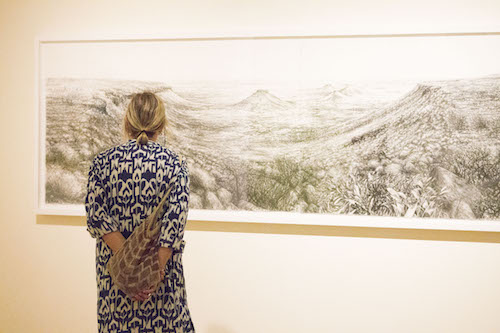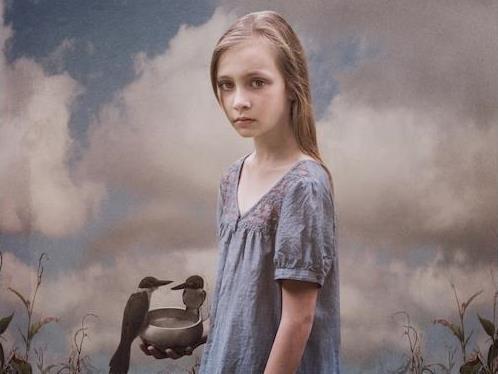Image: Dasha Riley, Thoughts of Spring, 2015, digital photograph, metallic print, 75 x 75 cm, ed. 2/7.
The often controversial competition also has another surprise for entrants – the winner will be chosen by MONA FOMA director Brian Ritchie.
Jason Quin, President of the Alice Springs Art Foundation who coordinate the prize, said the now biennial Prize, ongoing since 1970, has become one of the Territory’s most prestigious art events. The prize money boost is a celebration of its longevity and a recognition of its standing within Australia’s contemporary art space and reputation among artists.
‘There is a strong history of the Prize representing the diversity and the strength of Australian contemporary art across many mediums, and I think that is something that people do want to engage with,’ he said.
Often mistakenly assumed to be a strictly Indigenous competition, the purpose of the Alice Prize has always been to bring contemporary art to Alice Springs. It has also actively encouraged artists from all over Australia to explore their own relationship to the outback.

The winner and finalists in the Alice Prize are exhibited for two months in Alice Springs.
‘Contributions to the Alice Prize often wrestle with the dynamic around identity that Australia struggles with,’ says Quin. ‘I think that Australia suffers a schism where many are yet to come to terms with any sense of Aboriginality or the shared postcolonial history. It’s a long-standing, often problematic yet central part of the national identity, that idea of the frontier, of the remote outback, adapting to a harsh but inspiring landscape.
‘If given the opportunity, people are very much engaged with challenging their own ideas, abilities and perspectives in the context of remote Australia.’
Quin says contemporary artists from all over Australia are increasingly travelling to Alice Springs for the Prize’s opening night in April, and taking the opportunity to explore more remote areas of Central Australia for inspiration.
‘I think the Alice Prize does trigger and challenge people to reflect on a lot of those issues around identity where they don’t have to, don’t need to, in the context of their metropolitan centre,’ he said.
Learn more about the Alice Prize
The acquisitive Prize attracts more than 500 entries from across Australia and covers a multitude of mediums and themes. It has often courted controversy, ranging from heavy debates early in its history about the appropriateness of displaying traditional Aboriginal dot painting alongside contemporary artworks, to last year’s inclusion of a lightbox presented photograph by Kristian Laemmle-Ruff, of joint US and Australian military base Pine Gap, a facility so heavily guarded that photography of it is illegal.

Kristian Laemmle-Ruff, Pine Gap (a photograph of the Centre of Australia), 2015, Duratran print in Blackwood light-box, 37 x 128 x 19 cm, ed. 1/5. Araluen Art Collection. Acquired from the 39th Alice Prize, 2016.
The Araluen Arts Centre in Alice Springs, which hosts the Alice Prize exhibition and houses the significant collection that has grown from Alice Prize acquisitions across its history, acquired the Pine Gap work, which joined the winner, High Pine, by Naomi Hobson, as the latest additions to the collection. Several Prize artworks are curated each year into the collection and successful finalists whose works are exhibited will also be eligible to win the $1000 People’s Choice Award.
This year, Quin expects there to be some excitement about the Prize’s choice of judge – MONA FOMA curator and Violent Femmes bassist, Brian Ritchie. As with previous judges, he will anoint a single winner from the selection of roughly 70 finalists chosen by a selection panel – Kelli Cole, Curator of Aboriginal and Torres Strait Islander Art, National Gallery of Australia; Dr Felicity Fenner, Director, Gallery UNSW; and Luke Scholes, Curator of Aboriginal Art, MAGNT.
Quin says Ritchie has a strong connection to Alice Springs through his involvement with Indigenous music competition Bush Band Bash, and his appointment will provide a bold new perspective.
‘It’s a slight deviation for our 40th prize,’ he says. ‘We are taking a fresh look at what the Alice Prize can be and how it can be looked at by artists across Australia. The previous three judges have all been impressive and eminent people in the art world – all directors from state galleries so this is a departure but there is continuity in having strong and diverse perspectives.’
Entries are now open and will close 31 January. Finalists will be notified by mid-February with the opening night and winner announcement on 27 April. The exhibition of works will be hosted for two months. For more information and entry details, visit www.aliceprize.com.





